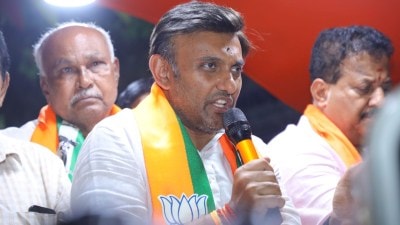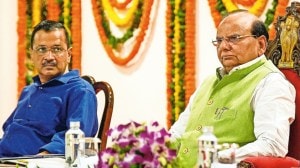- India
- International
Rs 6,000 investment and 15 months later, 10 women reap huge dividends from oysters
These women are among the first oyster farmers in the state.
 Kasturi Dhoke looks at oyster spats forming under shells left on bamboo frames. (Photo: Prashanth Vishwanathan/ UNDP India)
Kasturi Dhoke looks at oyster spats forming under shells left on bamboo frames. (Photo: Prashanth Vishwanathan/ UNDP India)
Ten women spent three days erecting bamboo frames with old, empty oyster shells in Wadatar creek in Sindhudurg in March last year.
Fifteen months later, the women made Rs 50,000 by harvesting 125 kg meat from 6,000 oysters. These women are among the first oyster farmers in the state.
“We no longer have to go looking for oysters in marshy areas of the creek and depend on luck. We can grow oysters and earn well with less effort. We are definitely planning to expand in our village and have also spread the news to other villagers,” said Kasturi Dhoke, 40, one of the farmers.
While the partial harvest last week yielded 125 kg meat, the estimated production from a single raft of 150 sq m is 187 kg in 15 months. This is part of a project by the United Nations Development Programme and Government of Maharashtra to create sustainable livelihoods in coastal communities.
[related-post]
Central Marine Fisheries Research Institute, Kochi (CMFRI), and Marine Product Export Development Authority (MPEDA) introduced these uneducated but skilled women to oyster farming. The project, which started with an initial investment of Rs 6,000 for bamboo, material and labour in March 2014, yielded eightfold returns.
After the success of the pilot project, the UNDP Sindhudurg project will now take oyster farming to coastal families in the three coastal talukas of Sindhudurg district — Devgad, Malvan and Vengurla. Further, as depurated oysters will provide four to five times profit, a Depuration Unit (meant for clearing the gut content of oysters) can be set up in the vicinity, said Dr P K Asokan from CMFRI.

The technology is simple, said Subir Ghosh, project coordinator of the UNDP Sindhudurg project. A raft using 450 ropes was set up with substrates or empty oyster shells on each bamboo frame. Naturally available oyster spats in the Wadatar creek adhered to these suspended substrates over time. Oyster farming is one of the cheapest and most environmentally-friendly options for sustainable livelihood in coastal areas, said forest officials.
“It is a win win situation for us,” said N Vasudevan, chief conservator of forests, mangrove cell. “This method needs no additional feed that is required for farming oysters. The naturally available oyster spats in the Wadatar creek adhere to these suspended substrates over time. Moreover, oysters being filter feeders, grow on plankton and detritus filtered from the creek water and essentially clean the environment they grow in. Plus, oyster meat generates more income than molluscs and mussels,” he said.
Apr 27: Latest News
- 01
- 02
- 03
- 04
- 05








































